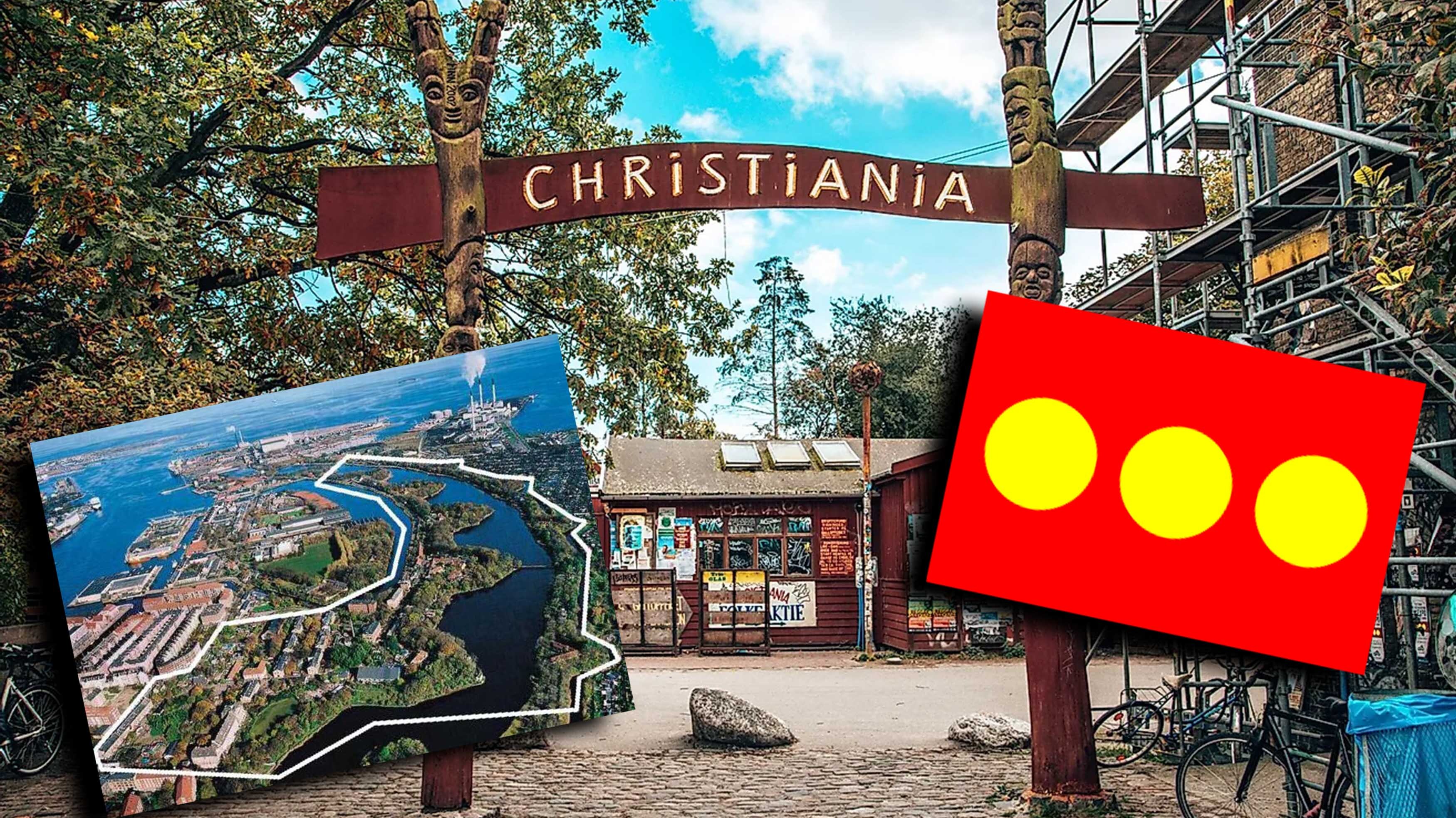Free Christiania: A Utopian Lawless Place
In the heart of Copenhagen, Denmark, a free-living socialist Utopia has existed for more than 50 years. What started as an abandoned military barracks has become a haven for free-thinkers, hippies artists and tourists where it seems everything is legal. But is it? In this episode, we examine the history and turmoil of Christiania and then chat with Comedian & Juggler, Marcus Monroe!

In the 4th grade, we had some playwrights come in as artists in residence and they helped us write our own play. What we came up with was a story about a bunch of kids who wished for a world with no rules and no parents and then of course, they come upon a genie and get what they ask for and then they get cold and eat too much candy and miss their parents and wish them back. It was sort of like Home Alone without all the good parts. So from my experience in having constructed and performed in a school play as a 9 year old, having a world without laws is bad.
What we’re talking about is known as anarchism. Anarchism is different than anarchy. Anarchy is the total rejection of laws and government whereas Anarchism refers to voluntary self-governed societies and is usually more of a political movement.
We can look at examples of both throughout history, but even today, there are places where there are simply no laws because it’s either a contested area as far as government, or it’s simply a no-man’s land where no government is really willing to support the region. We can see this in the Western Region of Afghanistan, where sections of the country are divided into different indigenous tribes. There are some areas that no tribe claims and so those areas are essentially lawless. Occasionally the Taliban has come in and claimed these areas, but the “Rebel Rule of Law” is the code there. One of the many problems with Afghanistan is the fight for jurisdiction and leadership in a lot of these areas. Parts of Yemen and Mali also are considered lawless because of contested or unclaimed regions.
Between Egypt and Sudan, there’s a small part of the border called Bir Tawil that is unclaimed and uninhabited that is considered a lawless area. One New Jersey man went there in 2014 to proclaim himself as the ruler just because he promised his daughter she could be a princess. I know you want to know more about that story, but I think I’m saving that one for its own episode.
But most of these areas that I’ve discussed aren’t areas where the citizens specifically set out to create a lawless society. Most of them don’t have citizens at all. To look for an area where a lawless society was the goal, we have to look toward areas where social movements created the desire. One of these is known as Slab City in the middle of the desert of Southern California. It’s a tiny off-the-grid alternative living community that inhabits an area that used to be a military facility. The people that live there don’t want to conform to society. A lot of its residents come in campers and just stay for the winter – as many as 4,000 – but around 150 live there year-round. The state of California owns the land, and there are constant battles as to the future of the area. It doesn’t collect taxes, but nearby police and fire authorities do provide service there.
A similar place in Denmark is what we’re going to talk about today – The Free Community of Christiania. A place where supposedly nothing is illegal. We’ll talk about it after the break.
If you visited Christiania around Christmastime, you would find it absolutely delightful. You’d wander through an indoor Christmas Market and smell baked almonds and mulled wine and end up shopping at for hand made items, maybe eat at one of the many street vendor stands.
But Christiania didn’t start as anything touristy. It actually started as an abandoned military base – similar to Slab City in California. It was originally an area that housed military barracks and the ramparts that protected the city of Copenhagen, Denmark. It was known as Christianshavn. It’s right there on the Southwest corner of Copenhagen – it’s right downtown. When the military abandoned the buildings in the area, they left behind a small number of watchmen, but homeless citizens of Copenhagen started moving in and residing in the buildings. At one point in 1971, citizens that lived nearby tore down the military fencing and built a playground. Some claim that it was an act of defiance. Copenhagen was facing a lack of affordable housing at the time, and here the government was just sitting on all of this abandoned housing and land downtown.
That same month that the fence was removed, a man named Jacob Ludvigsen, who was a journalist and sort of a hippie activist, declared the area of Christiania to be free and open. It wasn’t any sort of legal declaration. He just wrote it in his paper, the Hovebladet. He wrote:
“Christiania is the land of the settlers. It is the biggest opportunity so far to build up a society from scratch – while nevertheless still incorporating the remaining constructions. Own electricity plant, a bath-house, a giant athletics building, where all the seekers of peace could have their grand meditation – and yoga center. Halls where theater groups can feel at home. Buildings for the stoners who are too paranoid and weak to participate in the race … Yes for those who feel the beating of the pioneer heart there can be no doubt as to the purpose of Christiania. It is the part of the city which has been kept secret to us – but no more.”
And with that – it just…worked. Squatters, hippies and artists started moving in and the few military members that were there didn’t stop them. It’s worth noting that even the military members in Denmark in 1971 had long hair – they were part of the youth movement too. The Freetown of Christiania was born – an 84-acre community that even had its own mission statement:
“… to create a self-governing society whereby each and every individual holds themselves responsible over the wellbeing of the entire community … to be economically self-sustaining.”
And they were. People started building their own homes and shops in the area. If they needed an electrician, they didn’t call one. They either found another community member who could help or learned how to wire electricity. If they had a dispute, they didn’t call the police – they settled it themselves. The citizens of Christiania didn’t rely and didn’t recognize local authorities. They even had their own flag – a red flag with 3. Yellow dots. Each dot represents one of the “i’s” in Christiania. It was a small experiment in socialism that grew to around 1,000 permanent residents. One would think that this isn’t sustainable. That an area free from the government would soon be overrun with the worst of society. And maybe in most parts of the world, that would be true. But Danish people are different. And the experiment continues.
Today, Christiania still exists. Its main feature for years has been the so-called Green-Light District and Pusher Street, a street named for the drugs sold from street vendors – most popularly the open selling of hash – usually mixed strains of marijuana along with drinks and foods infused with cannabis. But over the last few years, crime has forced the open sale of any drugs in Christiania to stop. The people who live there won’t put up with crime, so they forced all of these stalls to close. It’s said that it’s still pretty easy to buy marijuana in the area, but just not out in the open. It’s worth noting that Christiania does have its own rules. One of those is that the sale of hard drugs is forbidden. They also don’t allow guns, knives, bulletproof vests, stealing and the wearing of bikers’ colors. Back in the mid 80s, there were some gang wars between the Hells Angels and Copenhagen’s Biker Club – their name was just “Bullshit.” No – that’s the name of the Biker Gang. Bullshit. It led to the murder of Bullshit’s leader who controlled the drug trade in Christiania. They also don’t allow running. No gang wars. No running. The idea of running to them means there’s something to run away from. They don’t approve of photography. There are no cars allowed – only bikes. It’s a small, walkable area and the self-governing seems to do pretty well.
There are several notable buildings and institutions in the free area. One of them is Gay House – a location that houses over-the-top LGBT variety shows and is a home for gay activism. The area is alive with music and art. Jazzclubben is a famous jazz club and at the end of Pusher Street is Woodstock – Christiania’s oldest bar. There’s also Copenhagen’s oldest skate park, ALIS in Wonderland.
As far as the rights to the land, the citizens of Christiania are constantly being threatened by developers and government officials who want to capitalize on the property, being so close to the capital city. In 1995, they came to an agreement with the Danish government to keep the land free as long as they began to pay taxes. So since 1995, they pay the city for trash removal and access to water and electricity.
Even so, Conservative Danish politicians have been trying to shut down Christiania for years. In 2004, the government tried to eradicate the free society. In 2005, there was a murder on Pusher Street over weed sales and it brought a lot of negative attention. In 2007, the city demolished a set of buildings in Christiania that were deemed unsafe. Young citizens defended the area, setting up roadblocks and shooting fireworks at police, but the buildings were demolished and 50 people went to jail.
In 2016, there was another drug-related shooting on Pusher Street and this was when they made the decision to close down the stalls that openly sold marijuana. It’s estimated that cannabis sales in Christiania dropped by 75%.
Today, there are still around 700 permanent residents of Christiania. The region is still under constant threat of development.
50 years after its founding, Christiania is still a community of artisans, artists, musicians and people who just want to live in their own view of freedom. The crime rate is actually very low, but so is the crime rate of Copenhagen – about 1/25th the crime rate in America. A million people a year visit Christiania for tourism.
They have their own anthem. It’s uh. It’s dramatic. And I’ll leave you with it. The lyrics are:
You have thrashed us with batons
Threatened us with weapons
To escape the painful sounding
Of your own children shouting
You hide behind your helmets and empty laws and bills
Soon you’ll see in anguish
It’s yourself that you punish
You Cannot Kill Us.
Review this podcast at https://podcasts.apple.com/us/podcast/the-internet-says-it-s-true/id1530853589
Bonus episodes and content available at http://Patreon.com/MichaelKent
For special discounts and links to our sponsors, visit http://theinternetsaysitstrue.com/deals


